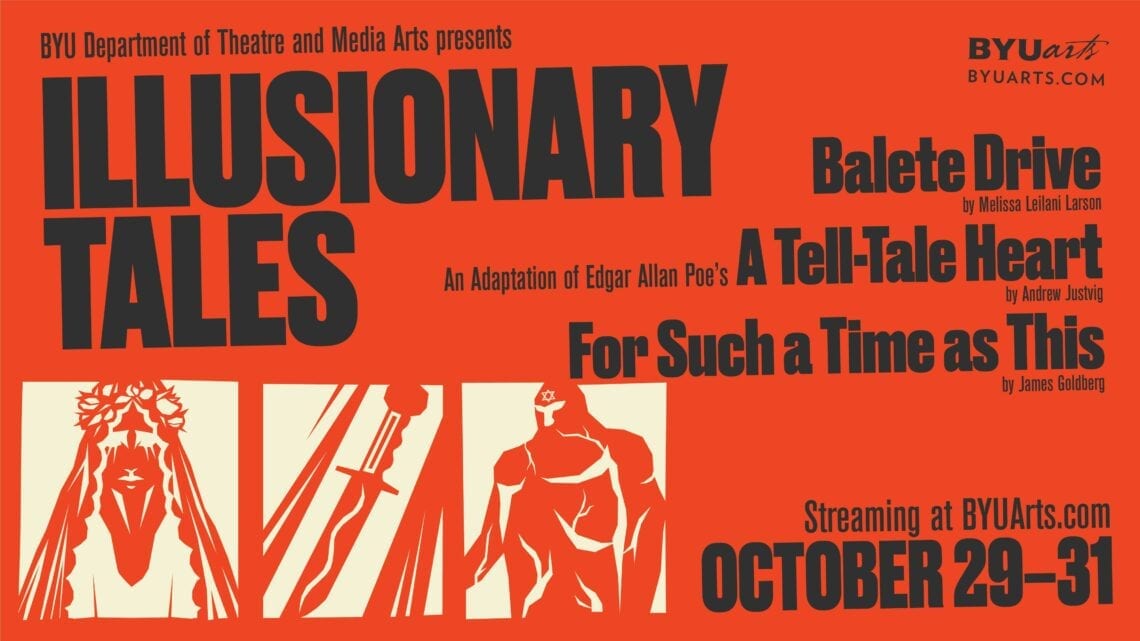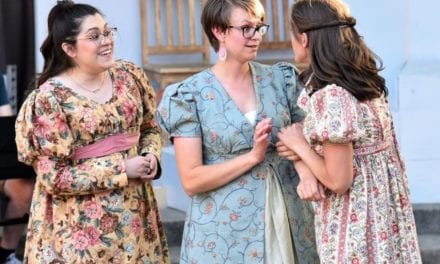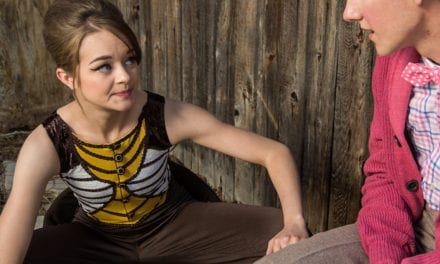PROVO — One of the few good things to come out of the pandemic is experimental theater, and BYU’s Illusionary Tales has done a great job of finding a way to entertain while social distancing. The live-streamed production is three short plays: Balete Drive, Such a Time as This, and A Tell-Tale Heart, that the university commissioned from playwrights Melissa Leilani Larson, James Goldberg, and Andrew Justvig, respectively. Each play had one actor on stage, with “illusionary” ghost characters played by other actors. These actors were socially distanced in other parts of the building, using Pepper’s Ghost to project them on stage. More information about the tech can be found on BYU’s 4th Wall Dramaturgy website; I am not tech-oriented enough to explain it any more without making it too confusing.

Show closed October 31, 2020.
The idea of using Pepper’s Ghost worked really well for directors Tony Gunn, Adam Houghton, and David Morgan, as the ghosts’ staging was impressive. However, the effect diluted some of the colors and details of the costumes, which is something that designers don’t normally have to take into account. Luckily, in-between shows they showed some behind the scenes photos of renderings, costumes, tech rehearsals, and crew building the sets, which let the audience see details that were lost due to both Pepper’s Ghost and the camera.
I was also able to attend the dramaturgy talkback after the show via Zoom (at one point there were 106 participants listed), which was a wonderful opportunity to listen to the playwrights and designers talk about their views and creative processes for the show.
Now for the actual plays themselves: Balete Drive was based on the Filipino urban legend of the same name, combined with the Hispanic legend of La Llorona. This play was the only play where an element of Pepper’s Ghost didn’t work; it was used for both the character of La Llorona and for Hunter Aro’s character, Felix, who is alive. Because Felix looked like the other projected ghosts, I kept waiting for them to reveal that, plot twist, he’s been dead the whole time. I understand that they could only have one actor on stage, and Malin C. Glade’s character, Carolina, made the most sense to be on stage, because she was the main character, but it was a little distracting.
Despite that confusion, the moment where (spoilers) Carolina gets in a car crash was one of my favorites of the night. The buildup with La Llorona’s wails and the car getting faster, the immediate slow-down of time, the lighting and sound of the car falling into the water, the way the smoke entered the stage, was all highly impressive. Jacob Pierce’s sound design and Emma Hansen’s lighting were both particularly nice in that moment. In fact, Hansen was the lighting designer for all three shows and made all the shows look excellent. Oftentimes in filmed stage shows, the lighting design that worked well on stage doesn’t get captured on camera, but Hansen made choices that showed up well on the recording.
Goldberg’s Such A Time As This is about a young woman, played by Sage Patchin, taking part in the Black Lives Matter protests, who calls on the ghost of her deceased father, Mordecai, played by Ian Buckley, to tell her the story of the Golem of Prague. These two actors were some of the most impressive of the night, especially with their accents. It’s rare to see such consistent and believable accents in college theater.
Elisabeth Goulding’s scenic design really stuck out from the moment it was revealed on stage: a slightly dingy city apartment, made happier with the addition of lots of plants. It looked well-lived in, and very realistic.
The only problem I had with the show was trying to figure out the point of the story. It felt like there was an important lesson trying to be taught, but between the characters trying to honor family traditions and attempting to protect the city, I couldn’t quite figure out what that lesson was. It also felt a tad out of place, as the other two plays were clearly horror, and this play was almost a heart-warming ghost story. It was a good play, but I was left marginally confused.
The final play of the night, Justvig’s A Tell-Tale Heart was an adaptation of Edgar Allan Poe’s famous The Tell-Tale Heart. It keeps the parts about a murder of passion, body parts hidden under the floorboards, and madness leading to a confession, but reimagines the reasons leading up to the murder. This time it is two sisters, played by Ondine Garner and Juniper Taylor, who are rivals in ballet.
Right off the bat, the first note I wrote down for this play was that blue is an excellent color for Poe, in the set, lighting, and costumes. It differs from the traditional—and slightly overused—red while still capturing the horror and macabre of the story. In the dramaturgy talkback, Goulding mentioned that her scenic design was inspired by 1920s German Expressionist films, with harsh angles and lines, which added so much to the feeling of the show.
I absolutely love the idea of a reverse ghost story (spoilers)—the audience sees Eliza, the dead sister, in person, while she attempts to communicate with the “ghosts” of her sister and a family friend—but there was something missing from the buildup to the show’s climax. The bulk of the story is spent following Eliza as she tries to figure out why she can partially see the two other characters and why they can’t see her, until suddenly Annabelle exclaims that she killed Eliza. The story is intriguing, but Annabelle went from charming to crazed killer too suddenly. All the elements for the audience to understand what was happening were there; they just weren’t fully pieced together. Still, I do adore the concept of the dead person seeing the ghosts of the living.
Overall, it was nice to see short plays based off of folklore; none of them needed to spend any time explaining the basics of the world of the play to the audience, because they’re all common stories. Illusionary Tales was a fun night of Halloween-y plays and was perfect for the season.





